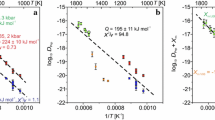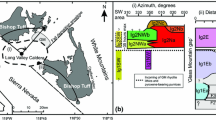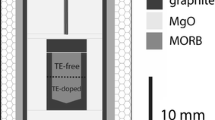Abstract
This paper describes a general technique, binary element diffusion modelling (BEDM), for determining single-crystal residence times in magmas that relies on modelling the diffusion of two or more elements in the crystal. BEDM has the advantage over other diffusion-based models in that it does not need a precisely defined initial compositional profile for the crystal at “zero time”, and instead requires that the concentrations of the two elements are correlated during crystallisation. Any differences subsequently observed between the two elements are caused by intracrystalline diffusion during residence in hot magma. These differences are removed by artificially ageing the slower-diffusing of the two elements, and the amount of time taken to “undo” the difference between the elements is simply related to the crystal residence time (=decoupling time) at high temperatures. The BEDM principle is demonstrated using artificial data and is then applied to literature data for Sr and Ba in a zoned sanidine crystal from the Bishop Tuff (Anderson et al., in J. Petrol 41(3):449–473, 2000). For this crystal, the method gives a residence time estimate of 114 ka at 800°C, which is then compared with estimates from other methods. In theory, the method can be further expanded for use as a geothermometer as well as geochronometer. However, this is not easily possible with the diffusivity data currently available.









Similar content being viewed by others
References
Albarède F, Bottinga Y (1972) Kinetic disequilibrium in trace element partitioning between phenocrysts and host lava. Geochim Cosmochim Acta 36:141–156
Anderson AT, Davis AM, Lu F (2000) Evolution of Bishop Tuff Rhyolitic Magma Based on Melt and Magnetite Inclusions and Zoned Phenocrysts. J Petrol 41(3):449–473
Blundy J, Wood B (1994) Prediction of crystal-melt partition coefficients from elastic moduli. Nature 372:452–454
Botazzi P, Tiepolo M, vannucci R, Zanetti A, Brumm R, Foley SF, Oberti R (1999) Distinct site preferences for heavy and light REE in amphibole and the prediction of Amph/L DREE. Contrib Mineral Petrol 137(1–2):36–45
Burton KW, Kohn MJ, Cohen AS, O’Nions RK (1995) The relative diffusion of Pb, Nd, Sr and O in garnet. Earth Planet Sci Lett 133:199–211
Chakraborty S (1997) Rates and mechanisms of Fe–Mg interdiffusion in olivine at 980°C–1300°C. J Geophys Res 102:12317–12331
Charlier B, Zellmer G (2000) Some remarks on U–Th mineral ages from igneous rocks with prolonged crystallisation histories. Earth Planet Sci Lett 183(3–4):457–469
Cherniak DJ (1996) Strontium diffusion in sanidine and albite, and general comments on strontium diffusion in alkali feldspars. Geochim Cosmochim Acta 60(24):5037–5043
Cherniak DJ (2002) Ba diffusion in feldspar. Geochim Cosmochim Acta 66(9):1641–1650
Cherniak DJ, Hanchar JM, Watson EB (1997a) Diffusion of tetravalent cations in zircon. Contrib Mineral Petrol 127:383–390
Cherniak DJ, Hanchar JM, Watson EB (1997b) Rare-earth diffusion in zircon. Chem Geol 134:289–301
Christensen JN, DePaolo DJ (1993) Timescale of large volume silicic magma systems: Sr isotopic systematics of phenocrysts and glass from the Bishop Tuff, Long Valley. Contrib Mineral Petrol 113:100–114
Christensen JN, Halliday AN (1996) Rb–Sr and Nd isotopic compositions of melt inclusions from the Bishop Tuff and the generation of silicic magma. Earth Planet Sci Lett 144:547–561
Condomines M, Hemond C, Allegre CJ (1988) U–Th–Ra radioactive disequilibria and magmatic processes. Earth Planet Sci Lett 90(3):243–262
Coogan LA, Hain A, Stahl S, Chakraborty S (2005) Experimental determination of the diffusion coefficient for calcium in olivine between 900°C and 1500°C. Geochim Cosmochim Acta 69(14):3683–3694
Coombs ML, Eichelberger JC, Rutherford MJ (2000) Magma storage and mixing conditions for the 1953–1974 eruptions of Southwest Trident Volcano, Katmai National Park, Alaska. Contrib Mineral Petrol 140(1):99–118
Cooper KM, Reid MR, Murrell MT, Clague DA (2001) Crystal and magma residence times at Kilauea Volcano, Hawaii: 230Th-226Ra dating of the 1955 east rift eruption. Earth Planet Sci Lett 184(3–4):703–718
Costa F, Chakraborty S (2004) Decadal time gaps between mafic intrusion and silicic eruption obtained from chemical zoning patterns in olivine. Earth Planet Sci Lett 227(3–4):517–530
Costa F, Dungan M (2005) Short time scales of magmatic assimilation from diffusion modeling of multiple elements in olivine. Geology 33(10):837–840
Costa F, Chakraborty S, Dohmen R (2003) Diffusion coupling between trace and major elements and a model for calculation of magma residence times using plagioclase. Geochim Cosmochim Acta 67(12):2189–2200
Crank J (1975) The mathematics of diffusion. Clarendon Press, pp 414
Davidson J, Tepley F III, Palacz Z, Meffan-Main S (2001) Magma recharge, contamination and residence times revealed by in situ laser ablation isotopic analysis of feldspar in volcanic rocks. Earth Planet Sci Lett 184:427–442
Davies GR, Halliday AN (1998) Development of the Long Valley rhyolite magma system: Strontium and neodymium isotope evidence from glasses and individual phenocrysts. Geochim Cosmochim Acta 62(21/22):3561–3574
Dobosi G (1989) Clinopyroxene zoning patterns in the young alkali basalts of Hungary and their petrogenetic significance. Contrib Mineral Petrol 101(1):112–121
Dohmen R, Becker H-W, Chakraborty S (2003) Point defect equilibration and diffusion in olivine at low temperatures (T< 1000°C). Euro J Mineral 15:42
Freer R (1981) Diffusion in silicate minerals and glasses: a data digest and guide to the literature. Contrib Mineral Petrol 76:440–454
Gagnevin D, Daly JS, Poli G, Morgan D (2005) Microchemical and Sr isotopic investigation of zoned K-feldspar megacrysts: insights into the petrogenesis of a plutonic system and disequilibrium processes during crystal growth. J Petrol 46(8):1689–1724
Ghiorso MS, Sack RO (1991) Fe–Ti oxide geothermometry — thermodynamic formulation and the estimation of intensive variables in silicic magmas. Contrib Mineral Petrol 108(4):485–510
Giletti BJ, Casserly JED (1994) Strontium diffusion kinetics in plagioclase feldspars. Geochim Cosmochim Acta 58:3785–3793
Ginibre C, Kronz A, Worner G (2002) High-resolution quantitative imaging of plagioclase composition using accumulated backscattered electron images: new constraints on oscillatory zoning. Contrib Mineral Petrol 142(4):436–448
Green TH, Pearson NJ (1985) Rare earth element partitioning between clinopyroxene and silicate liquid at moderate to high pressure. Contrib Mineral Petrol 91:24–36
Hammond PA, Taylor LA (1982) The ilmenite / titano-magnetite assemblage: kinetics of re-equilibration. Earth Planet Sci Lett 61:143–150
Hawkesworth CJ, Blake S, Evans P, Hughes R, Macdonald R, Thomas LE, Turner SP, Zellmer G (2000) Time scales of crystal fractionation in magma chambers — integrating physical, isotopic and geochemical perspectives. J Petrol 41(7):991–1006
Hildreth EW (1977) The magma chamber of the Bishop Tuff: gradients in temperature, pressure and composition. University of California, Berkeley, pp 328
Hildreth EW (1979) The Bishop Tuff: evidence for the origin of the compositional zonation in silicic magma chambers. Geological Society of America, Special Paper 180:43–76
Humler E, Whitechurch H (1988) Petrology of basalts from the Central Indian Ridge (lat 25°23′S, long 70°04′E): estimates of frequencies and fractional volumes of magma injections in a two-layered reservoir. Earth Planet Sci Lett 88:169–181
Jaoul O, Sautter V (1999) A new approach to geospeedometry based on the “compensation law”. Phys Earth Planet Interiors 110:95–114
Lasaga AC (1983) Geospeedometry: an extension of geothermometry. In: Saxena SK (eds) Kinetics and equilibrium in mineral reactions. Springer, Berlin Heidelberg New York, pp 82–114
Lasaga AC, Jiang J (1995) Thermal history of rocks: P–T–t paths from geospeedometry, petrologic data and inverse theory techniques. Am J Sci 295:697–741
Liu C-Q, Masuda A, Shimizu H, Takahashi K, Xie G-H (1992) Evidence for pressure dependence of the peak position in the REE mineral / melt partition patterns of clinopyroxene. Geochim Cosmochim Acta 56:1523–1530
Long PE (1978) Experimental determination of partition coefficients for Rb, Sr, and Ba between alkali feldspar and silicate liquid. Geochim Cosmochim Acta 42:833–846
Lu F, Anderson AT, Davis AM (1992) New and larger sanidine/melt partition coefficients for Ba and Sr as determined by ion microprobe analyses of melt inclusions and their sanidine host crystals. Geological Society of America, Abstracts with Programs 24:A44
Magaritz M, Hofmann AW (1978) Diffusion of Sr, Ba and Na in obsidian. Geochim Cosmochim Acta 42:595–605
Morgan DJ, Blake S, Rogers NW, De Vivo B, Rolandi G, Macdonald R, Hawkesworth CJ (2004) Timescales of crystal residence and magma chamber volume from modelling of diffusion profiles in phenocrysts: Vesuvius 1944. Earth Planet Sci Lett 222(3–4):933–946
Nakamura M (1995) Continuous mixing of crystal mush and replenished magma in the ongoing Unzen eruption. Geology 23(9):807–810
Petry C, Chakraborty S, Palme H (2004) Experimental determination of Ni diffusion coefficients in olivine and their dependence on temperature, composition, oxygen fugacity, and crystallographic orientation. Geochim Cosmochim Acta 68(20):4179–4188
Shannon RD (1976) Revised effective ionic radii and systematic studies of interatomic distances in halides and chalcogenides. Acta Crystallogr A32:751–767
Shore M, Fowler AD (1996) Oscillatory zoning in minerals: a common phenomenon. Can Mineral 34:1111–1126
Simonetti A, Shore M, Bell K (1996) Diopside phenocrysts from nephelinite lavas, Napak volcano, eastern Uganda: evidence for magma mixing. Can Mineral 34(2):411–421
Smith V, Tiller WA, Rutter JW (1955) A mathematical analysis of solute redistribution during solidification. Can J Phys 33:723–744
van den Bogaard P, Schirnick C (1995) 40Ar/39Ar laser probe ages of Bishop Tuff quartz phenocrysts substantiate long-lived silicic chamber at Long Valley, United States. Geology 23:759–762
Van Orman JA, Grove TL, Shimizu N (2001) Rare earth element diffusion in diopside: influence of temperature, pressure, and ionic radius, and an elastic model for diffusion in silicates. Contrib Mineral Petrol 141(6):687–703
Venezky DY, Rutherford MJ (1999) Petrology and Fe–Ti oxide re-equilibration of the 1991 Mount Unzen mixed magma. J Volcanol Geother Res 89:213–230
Wood BJ, Blundy JD (1997) A predictive model for rare earth element partitioning between clinopyroxene and anhydrous silicate melt. Contrib Mineral Petrol 129:166–181
Zellmer GF, Blake S, Vance D, Hawkesworth C, Turner S (1999) Short plagioclase residence times at two island arc volcanoes (Kameni islands, Santorini, and Soufriere, St. Vincent) determined by Sr diffusion systematics. Contrib Mineral Petrol 136:345–357
Acknowledgements
Fred Anderson, Andy Davis and Louise Thomas are thanked for their kind permission to use their ion-probe data; and the constructive comments from Dr Nick Rogers greatly improved earlier drafts of this manuscript. Constructive and helpful reviews from Daniele Cherniak and Jon Blundy improved the accuracy and clarity of the manuscript. DJM gratefully acknowledges the support of an NERC studentship during the early stages of this work and the later work was supported by ERUPT, EU 5th framework contract number EVG1-CT2002-00058. This paper came about as a result of work presented at the Penrose 2000 conference on the Longevity and Dynamics of Silicic Magma Systems, which the authors both attended.
Author information
Authors and Affiliations
Corresponding author
Additional information
Communicated by I. Parsons
Appendix
Appendix
Theoretical extensions to BEDM: multi-element modelling
Should diffusivity data for a wide range of analysable elements become available, BEDM can be expanded to run with multiple pairs of elements for a better set of constraints. Notably, if the diffusivities show different responses to temperature increase, i.e. have different activation energies of diffusion, then it should be possible to use this method to obtain both the residence time and the magmatic temperature of equilibration simultaneously. In order to get strongly different activation energy for diffusion, a difference in ionic charge is often, but not always, necessary. Exceptions exist for minerals such as zircon, where activation energy is a strong function of ionic radius (Cherniak, et al. 1997a, b). It has been noted that site binding energy is essentially a function of ionic charge (Wood and Blundy 1997), and that site binding energy is a primary determinant of the activation energy of diffusion. This leads to the so-called “compensation law” where the lines of log D vs 1/T are parallel for ions of the same charge in the same site in the same mineral (Jaoul and Sautter 1999). Therefore, two ions of differing charge will have markedly different responses to temperature, and the ratio of the diffusivities will change as T is varied. In a set of three diffusing ions, if one has a valency different from the other two, running the three possible pairs within the binary element model will only produce the same answer if the temperature is correct and, therefore, the relative diffusivity ratios are also correct. In a graph showing ratios of residence time between element pairs versus temperature of equilibration, this will be the point at which the three lines from each set of modelled ions intersect, shown in Fig. 10.
As it currently stands, this approach will have limited application. Olivine may be a possible starting point (Costa and Dungan 2005), where Ca, Fe–Mg, Ni and Mn diffusion coefficients are known. However, as these authors show, although different elements do give consistent answers and imply the same zonation process (obeying BEDM assumptions), the uncertainties in the diffusion coefficients mean that the timescales are quite different. Therefore, using BEDM in the manner described here with these olivine diffusion coefficients would give quite a wide range in T–time estimates, within uncertainty. In addition, use of BEDM for temperature determinations requires some variation in diffusional activation energy and the listed elements are all quite similar. Therefore, alkali feldspar (for Rb, Sr and Ba diffusion) may be more productive, as these elements sit in the same site in the lattice despite different valency, and have different activation energies.
Rights and permissions
About this article
Cite this article
Morgan, D., Blake, S. Magmatic residence times of zoned phenocrysts: introduction and application of the binary element diffusion modelling (BEDM) technique. Contrib Mineral Petrol 151, 58–70 (2006). https://doi.org/10.1007/s00410-005-0045-4
Received:
Accepted:
Published:
Issue Date:
DOI: https://doi.org/10.1007/s00410-005-0045-4





